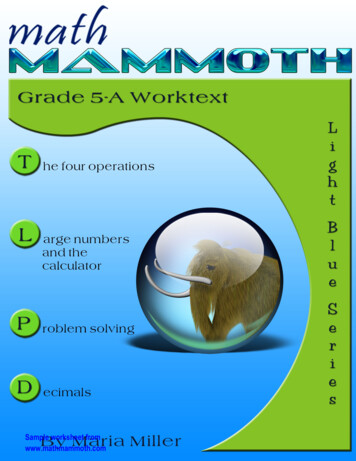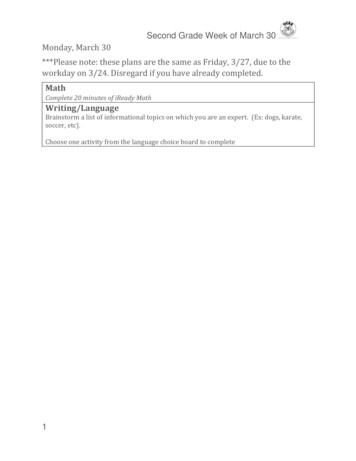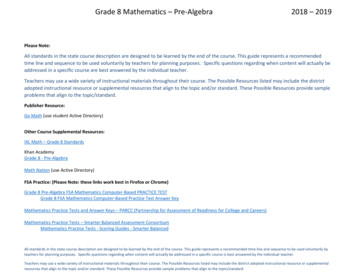
Transcription
Sample worksheet fromwww.mathmammoth.com
ContentsForeword .5Chapter 1: The Four OperationsIntroduction .6Warm Up: Mental Math .11The Order of Operations and Equations .13Review: Addition and Subtraction .16Review: Multiplication and Division .19Multiplying in Parts .23The Multiplication Algorithm .29More Multiplication .34Long Division .39A Two-Digit Divisor 1 .43A Two-Digit Divisor 2 .47Long Division and Repeated Subtraction .50Divisibility Rules .55Review: Factors and Primes .60Prime Factorization .64Chapter 1 Review .69Chapter 2: Large Numbers and the CalculatorIntroduction .72A Little Bit of Millions .75Place Value up to Billions .78Exponents and Powers .82Adding and Subtracting Large Numbers .85Rounding 1 .88The Calculator and Estimating .91When to Use the Calculator .94Mixed Review .96Review .98Sample worksheet fromwww.mathmammoth.com3
Chapter 3: Problem SolvingIntroduction .101Balance Problems and Equations .103More Equations .108Problem Solving with Bar Models 1 .112Problem Solving with Bar Models 2 .115Problem Solving with Bar Models 3 .117Problem Solving with Bar Models 4 .119Mixed Review .123Chapter 3 Review .125Chapter 4: DecimalsIntroduction .128Review: Tenths and Hundredths .135More Decimals: Thousandths .138Comparing Decimals .143Rounding 2 .145Add and Subtract Decimals .147Multiplying Decimals by Whole Numbers .151Multiplying Decimals in Columns .155Multiplying Decimals by Decimals .157More Decimal Multiplication .161Long Multiplication .164Dividing Decimals—Mental Math .165Long Division with Decimals .170More Long Division with Decimals .174Multiply and Divide by Powers of Ten .177Divide Decimals by Decimals 1 .182Divide Decimals by Decimals 2 .185Decimals in Measuring Units and More .189Rounding and Estimating .193The Metric System .195Converting Between Customary Units of Measurement .198Number Rules Puzzles .202Problem Solving .203Mixed Review .207Review .209Sample worksheet fromwww.mathmammoth.com4
ForewordMath Mammoth Grade 5-A and Grade 5-B worktexts comprise a complete math curriculum for the fifthgrade mathematics studies that meets and exceeds the Common Core Standards.Fifth grade is the time to focus on fractions and decimals and their operations in great detail. Students alsodeepen their understanding of whole numbers, get introduced to the calculator, learn more problemsolving and geometry, and study statistical graphs.The year starts out with a study of whole numbers and their operations. Students review multi-digitmultiplication and learn long division with two-digit divisors. We also review divisibility and primefactorization from fourth grade.In the second chapter, the focus is on large numbers and using a calculator. This is the first time acalculator is introduced in Math Mammoth complete curriculum — thus far, all calculations have beendone with mental math or with paper and pencil. I want students to learn to be critical in their use of thecalculator and use it with good judgment. Every exercise where calculator use is allowed is marked with alittle picture of a calculator.The third chapter is about equations and problem solving. We study simple equations with the help of abalance and bar models. The main goal is to get students used to the concept of an equation and what itmeans to solve an equation. Students also solve a fair amount of word problem with the help of the visualbar model.The fourth chapter is about decimals and their operations. It is a long chapter because now it is time forstudents to learn all the basic operations with decimals. I assume that the student already understandsdecimal place value (for example from studying Math Mammoth Grade 4 curriculum), because that is thefoundation for learning the concepts of decimal arithmetic and the means of preventing commonmisconceptions.In part 5-B, students study common statistical graphs, operations with fractions, and geometry.I wish you success with teaching math!Maria Miller, the authorSample worksheet fromwww.mathmammoth.com5
Chapter 1: The Four OperationsIntroductionWe start fifth grade by studying the four basic operations. This includes studying the order of operations,simple equations and expressions, long multiplication, long division, divisibility, primes, and factoring.The main line of thought throughout this chapter is that of a mathematical expression. In mathematics, anexpression consists of numbers, letters, and operation symbols, but does not contain an equal sign (anequation does). Students write simple expressions for problems which they solve. They study the correctorder of operations in an expression.An equation in mathematics consists of an expression that equals another expression (expression expression). We study simple equations, both with and without the help of visual bar models.Next, we review multi-digit multiplication (multiplying in columns), starting with partial products(multiplying in parts) and how that can be visualized geometrically. Then it is time for long division,especially practicing long division with two-digit divisors. We also study why long division works, in thelesson Long Division and Repeated Subtraction. Throughout the lessons there are also word problems tosolve.Lastly, we study the topics of divisibility, primes, and factoring. Students learn the common divisibilityrules for 2, 3, 4, 5, 6, 8, 9, and 10. In prime factorization, we use factor trees.Although the chapter is named “The Four Operations,” please notice that the idea is not to practice eachof the four operations separately, but rather to see how they are used together in solving problems and insimple equations. We are trying to develop the students’ algebraic thinking, including the abilities to:translate problems into mathematical operations, comprehend the many operations needed to yield ananswer to a problem, “undo” operations, and so on. Many of the ideas in this chapter are preparing themin advance for algebra.The Lessons in Chapter 1pagespanWarm Up: Mental Math .112 pagesThe Order of Operations and Equations .133 pagesReview: Addition and Subtraction .163 pagesReview: Multiplication and Division .194 pagesMultiplying in Parts .236 pagesThe Multiplication Algorithm .295 pagesMore Multiplication .345 pagesLong Division .394 pagesA Two-Digit Divisor 1 .434 pagesA Two-Digit Divisor 2 .473 pagesLong Division and Repeated Subtraction . 505 pagesDivisibility Rules .555 pagesReview: Factors and Primes .604 pagesPrime Factorization .645 pagesChapter 1 Review .693 pagesSample worksheet fromwww.mathmammoth.com6
Helpful Resources on the InternetMENTAL MATHMath MahjongA Mahjong game where you need to match tiles with the same xed mahjong/mahjongMath Level 3.htmlPop the BalloonsPop the balloons in the order of their value. You need to use all four es/numberballoons/BalloonPopMixed.htmORDER OF OPERATIONSInteractive Order of Operations PracticeClick on the correct operation in the expression.http://www.softschools.com/math/order of operations/games/Order of Operations PracticeA simple online quiz of 10 questions. Uses parentheses and the four -of-operations-practice.htmlThe Order of Operations MillionaireAnswer multiple-choice questions that have to do with the order of operations, and win a lExploring the Order of Operations (Object Interactive)Click on the correct operation to be done first in the given expression. The program then solves thatoperation, and you click on the next operation to be performed. Lastly the resource includes a game whereyou click on the falling blocks in the order that the order of operations would tml/object interactives/order of operations/use it.htmlChoose Math OperationChoose the mathematical operation(s) that make the equation true. Practice the role of zero and one inbasic operations or operations with negative numbers. Helps develop number sense and logical ame.phpQuick CalculatePractice your arithmetic with all four operations plus the order of operations.http://www.mathplayground.com/quick calculate.htmlFree worksheets for the order of operationsGenerate printable and customizable worksheets for the order of operations. Choose from five operationsand parentheses. You can choose the number range used, the number of problems, and r of operations.phpBAR MODELSThinking Blocks: Addition and SubtractionModel and solve addition and subtraction word problems using this interactive math tool.http://www.mathplayground.com/tb addition/thinking blocks addition subtraction.htmlSample worksheet fromwww.mathmammoth.com7
Thinking Blocks: Multiplication and DivisionModel and solve multiplication and division word problems using this interactive math tool.http://www.mathplayground.com/tb multiplication/thinking blocks multiplication division.htmlFUN WITH PROBLEM SOLVINGCalculator ChaosMost of the keys have fallen off the calculator. Make certain numbers using the keys that are left.http://www.mathplayground.com/calculator chaos.htmlSpeedMath DeluxeCreate an equation from the four given digits using addition, subtraction, multiplication and division.Make certain that you remember the order of operations. It sometimes includes negative tmlRandom CoinsCan you make 1.00 from Random Coins? Drag and drop the s.htmlLONG DIVISION & MULTIPLICATIONAmoeba Multiplication GamePractice partial products, or multiplication by splitting numbers. Choose “Medium ion/multiplication.swfArea and the Distributive PropertyPractice the idea how partial products tie in with the area of a rectangle (the distributive tributive-propertyMultiply 2-Digit Numbers with Area ModelUse an area model to decompose factors and Estimator QuizPractice your estimation skills in this customizable interactive quiz. Choose tivate/activities/EstimatorQuiz/Interactive Multiplication PracticeImprove your multi-digit multiplication skills with this 10-question online tiplication with MoneySpin the wheel. At the end of each spin, practice multiplying amounts of eel-team-gameDrag and Drop MathAn interactive tool to practice long division or long -math/Mr. Martini’s Classroom: Long DivisionAn interactive long division thmetic/longdivision.htmlSample worksheet fromwww.mathmammoth.com8
Long DivisionSolve long division problems interactively. Choose the levels with 2-digit divisors.http://www.longdiv.co.uk/activity/Long Division Tic Tac ToePlay Tic Tac Toe while solving long division problems. This exercise has multiple-choice ong Division by “Chunking”Solve division problems by using the “chunking method” — also called division by repeated ty/index.htmShort DivisionA page that explains short division in detail. Short division is the same algorithm as long division, butsome steps are only done in one’s head, not written -numbers.htmFACTORS AND PRIMESDivisibility Quiz GeneratorGenerate customized quizzes to practice the rules of ic/numbers/divisibility-quiz.phpArrays and factorsDrag rectangles to show the factorizations of a given number on a s/FactorizeTwo/Octopus FactorsMove counters up the legs of an octopus but only when the number on the circle is a multiple of thenumber on the pus/Sliding Tile Factorization GameSlide a number over another to capture it. You can only do this if the number you slide is a factor of theother. Number 1 is only supposed to be used to capture prime iding factors.htmlNot a FactorChoose a number that is not a factor of the given mes/target factors01/not factor.htmlFactor GameChoose a number from the game board, and your opponent gets all the numbers that are its proper factors.Adjust the number of rows and columns on the game board to get a more challenging game. This gamecan easily be adapted to be played offline, with paper and colored x?id 4134Factors and RemaindersAn interactive animation that illustrates factors and remainders. Choose a number and its possible divisor.The animation shows boxes arranged into rows, and you can see if there is any .action?quick mlSample worksheet fromwww.mathmammoth.com9
Product GameThe players choose factors and the product of those are colored in on the game board. The player whogets four products in a row wins. You can play against the computer or with a friend. This game caneasily be adapted to be played offline, with paper and colored x?id 4213Factorization ForestA fun game where for each number you factorize, you will get to grow a tree in your forest!http://mrnussbaum.com/forest/Factor Trees at Math PlaygroundFactor numbers to their prime factors using an interactive factor lMathGoodies Interactive Factor Tree GameType the missing number into the factor tree, and you will see the factor tree being drawn.http://www.mathgoodies.com/factors/prime factors.htmlPrime Number CalculatorThis calculator tests if a number is prime, and tells you its smallest divisor if it is not r-calculator.htmlFOR FURTHER STUDYUnique Prime FactorizationA video explaining the fundamental theorem of arithmetic: that each composite number has a uniqueprime factorization.http://www.youtube.com/watch?v 5kl28hmhin0Primes, Factors and Divisibility—Explorer at CountOn.orgExplore and learn more about divisibility tests, primes, and factors.http://www.counton.org/explorer/primesThe Prime PagesLearn about the largest known primes, how primes are found, how many there are, and more.http://primes.utm.edu/The Cryptoclub. Using Mathematics to Make and Break Secret Codes (book)Cryptoclub kids try to break the codes of secret messages, and at the same time learn more and moreabout encrypting and decrypting. The book contains problems to solve at the end of each chapter, littletips, and historical information on how cryptography has been used over the 23X?tag mathmammoth-20Primality of 1 from WikipediaDiscussing whether 1 should or should not be counted as a prime number.http://en.wikipedia.org/wiki/Prime number#Primality of ple worksheet fromwww.mathmammoth.com10
(This page intentionally left blank.)Sample worksheet fromwww.mathmammoth.com
More MultiplicationNow we will study the multiplication algorithm with a 3-digit number on the bottom. This meanswe have three partial products to do, so the multiplication process takes three lines.2 6114 2 9 2 2 74 2 9 2 2 74 2 9 2 2 74 2 9 2 2 73 0 0 33 0 0 38 5 8 03 0 0 38 5 8 08 5 8 0 03 0 0 38 5 8 0 8 5 8 0 0Next multiply 20 429.Place a zero in theones place, and thenmultiply as if it was just2 429.Then, 200 429.Since you are multiplyingby 200, place a zero in theones and in the tens places,and then multiply 2 429.9 7 3 8 3First multiply7 429, ignoringthe 2 and 2 in 227.1. Multiply. Remember: you will need to place two zeros in the third line.a.b.c.d.e.f.Sample worksheet fromwww.mathmammoth.com34Lastly add.
2. First estimate. Then multiply. Lastly, check that your final answer is reasonably close to yourestimate.a. Estimate:b. Estimate:c. Estimate:1 4 9 1 2 72 0 8 5 3 56 2 7 0 4 4 5d. Estimate:e. Estimate:f. Estimate:9 0 5 1 6 8 22 1 4 4 3 8 15 5 2 9 3 3 63. Let’s review! Multiply mentally. Remember the shortcut? Multiply without the zeros, then tag as many zeros atthe end of the answer as there are in the factors.a. 500 200 b. 30 210 c. 250 40 d. 2,000 400 e. 1,200 800 f. 30 40 50 g. 20 800 200 h. 50 80 300 Sample worksheet fromwww.mathmammoth.com35
When the factors end in zeros, we can take a shortcut! Study the examples carefully.Example 1:Example 2:4 1 11 14 1 19 5 6 2 0 09 5 0 8 2 09 5 8 21 9 1 2 0 00 0 01 9 0 0 0 7 6 0 0 0 01 9 0 7 6 0 0Here, you can first placetwo zeros in the ones andtens places in the answer,and then just multiply 2 956.7 7 9 07 7 9 0 0 0Be careful. the first “line” consiststotally of zeros. On the second line,first place a zero, then multiply. Onthe third line, first place TWO zeros,then multiply.It is easier to multiply82 95 and tag twozeros to the finalanswer to get 779,000.4. Multiply.a. 500 29 b. 340 210 c. 280 700 Simply multiply 5 29,then tag zeros to thefinal answer.Multiply ,then tag zeros to thefinal answer.Multiply ,then tag zeros to thefinal answer.d. 99 9,900 e. 600 1,800 f. 24,500 30 Sample worksheet fromwww.mathmammoth.com36
(This page intentionally left blank.)Sample worksheet fromwww.mathmammoth.com
A Two-Digit Divisor 21. Divide. Use the space on the left to write a multiplication table of the divisor. Lastly check.2 37 74a.b.c.Sample worksheet fromwww.mathmammoth.com37 ) 4 1 0 7 3 7 5 8 9 658 ) 4 4 0 896 ) 9 7 9 247
2. Divide. Use the space on the left to write a multiplication table of the divisor. Lastly check.Sample worksheet fromwww.mathmammoth.coma.48 ) 6 0 1 1b.92 ) 8 7 1 2c.55 ) 6 7 4 548
3. Angela is going to borrow money so she can purchasethree beds for 156 each. She will pay back the loan in12 equal payments, over one year.How much is one payment?4. Mark paid 4/15 of his 3,600 salary in taxes.a. How much did Mark pay in taxes?(Hint: First find 1/15 of his salary.)b. How much does Mark have left after taxes?5. If you need more practice, solve the problems below and fill in the cross-number puzzle.Use your notebook for long divisions.DownAcrossa. 3,762 66a. 2,295 45b. 19,750 5b. 2,870 82c. 9,960 12c. 9,240 11d. 27,339 13d. 9,660 35e. 9,384 23e. 9,306 22f. 9,135 15f. 15,243 3b.a.d.f.c.e.Check if you can solve these long divisions with a 3-digit divisor!These may have a remainder. Use your notebook.a. 12,408 118Sample worksheet fromwww.mathmammoth.comb. 70,854 23549f.
(This page intentionally left blank.)Sample worksheet fromwww.mathmammoth.com
Chapter 2: Large Numbers and the CalculatorIntroductionIn this chapter, we study large numbers and place value up to billions—that is, up to 12-digit numbers.We study adding, subtracting, rounding, exponents, and using a calculator.This is the first time a calculator is introduced in the Math Mammoth complete curriculum. I have delayedintroducing the use of a calculator (as compared to many other math curricula) for good reasons. I havereceived numerous comments on the harm that indiscriminate calculator usage can cause. If children areallowed to use calculators freely, their minds get “lazy,” and they will start relying on calculators even forsimple things such as 6 7 or 320 50. It is just human nature!As a result, students may enter college without even knowing their multiplication tables by heart. Thenthey have trouble if they are required to use mental math to solve simple problems.Therefore, we educators need to limit calculator usage until the students are much older. Children cannotdecide this for themselves, and definitely not in fifth grade.However, I realize that the calculator is extremely useful, and students do need to learn to use it. In thiscurriculum, I try to not only show the students how to use a calculator, but also when to use it and whennot to use it.This chapter includes many problems where calculator usage is appropriate. We also practice estimatingthe result before using a calculator to find the exact answer. In the last lesson, students need to choosewhether mental math or a calculator is the best “tool” for the calculation.The Lessons in Chapter 2pagespanA Little Bit of Millions .753 pagesPlace Value Up to Billions .784 pagesExponents and Powers . 823 pagesAdding and Subtracting Large Numbers .853 pagesRounding 2 .883 pagesThe Calculator and Estimating .913 pagesWhen to Use the Calculator .942 pagesMixed Review .962 pagesReview .983 pagesSample worksheet fromwww.mathmammoth.com72
Helpful Resources on the InternetExpanded Form QuizPractice addition in expanded form with this 10-question quiz.https://www.thatquiz.org/tq-c/?-j28-l9-p0Can you say really big numbers?Enter a really big number, try to say it out loud, and see it umbers.htmlFruit Splat Compare NumbersCompare numbers by choosing , , or . Choose level evalue/FSCompareNumbers.htmPlace Value QuizPractice identifying the place values of the digits in large numbers with this 10-question quiz.https://www.thatquiz.org/tq-c/?-j21-l9-p0Quiz on Large NumbersTest your knowledge about numbers with this 10-question multiple choice ?title NTczNDc3Megapenny ProjectThis page visualizes big numbers with pictures of aspPowers of TenA 9-minute movie that illustrates the dramatic changes of scale when zooming in or out by powers of ten(40 powers of ten), starting from a picnic blanket and ending in the universe, and then starting from ahand, all the way to a proton inside an atom.http://www.youtube.com/watch?v 0fKBhvDjuy0Free Exponent WorksheetsCreate a variety of customizable and printable worksheets to practice /exponents.phpExponents Quiz from ThatQuiz.orgA 10-question quiz, fairly easy, and not timed. You can change the parameters as you d MathChoose “POW’ to practice exponents. Drag the triangle with the right answer to the Picture Matching - Exponent ValuesMatch the powers with their values and reveal a pretty ample worksheet fromwww.mathmammoth.com73
Exponent GameA card game to practice exponents. Limit the cards to small numbers, instead of using the whole -game.htmlOtter RushChoose the correct value for “x” in exponent expressions (such as 2x 16) in this racing game.htmlAdding and Subtracting Powers of TenThis interactive quiz practices adding and subtracting powers of ten with numbers up to ING AND ESTIMATINGRounding QuizPractice rounding large numbers in this interactive 10-question ing/quiz837.htmlHome Run Derby MathReinforce number sense and estimating sums, differences, and products of four and five-digit numberswith this math baseball game.http://mrnussbaum.com/derbyEstimation Valley GamePractice estimation with this math golf game. The better you estimate, the more accurate your tion at AAA MathExercises about rounding whole numbers and decimals, front-end estimation, estimating sums anddifferences. Each page has an explanation, interactive practice, and ing a CalculatorPractice your calculator skills with this challenging quiz! Note: Some of the questions use concepts notstudied in this grade.http://www.transum.org/software/SW/Starter of the day/Students/Using A Calculator.asp?Level 1Powers PuzzleThis exploratory math exercise will get students to exploring numbers with the use of a .com/powers-puzzle.htmlSample worksheet fromwww.mathmammoth.com74
(This page intentionally left blank.)Sample worksheet fromwww.mathmammoth.com
Adding and Subtracting Large NumbersJust like 25 marbles 54 marbles 79 marbles, so will 25 million 54 million 79 million.Just keep in mind: a thousand thousands makes a million, and a thousand millions makes a billion.800,000 200,000Half a millionThink of it as
Math Mammoth Grade 5-A and Grade 5-B worktexts comprise a complete math curriculum for the fifth grade mathematics studies that meets and exceeds the Common Core Standards. Fifth grade is the time to










